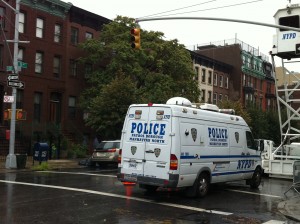Jaylene Clark was the mastermind behind the spoken word performance “Renaissance in the Belly of a Killer Whale.” The play stemmed from a random Facebook status she wrote before she was on her way to a poetry reading. It read: “It’s time to stop dipping a toe in here/ Wading in a little bit there/I need to jump back into this Sea World of poetry like I’m Shamu/ Heavy/ Too much gentrification going on in Harlem to get light/ Time to spit killer lines, with killer rhymes, of killer tales/ Cuz Harlem is looking more and more like the belly of a killer whale.”
The play takes a look at gentrification as actresses Janelle Heatley, Hollis Heath and Jaylene play the roles of three different young women discussing the changes in Harlem. The most prominent change being how Jaylene’s character’s parents are struggling to keep their brownstone apartment because of the increase in costs with real estate.
As the play goes on, the three actresses play different roles expressing their feelings on how Harlem was, how it is now, and how they hope it will be. Mostly, how they hope Harlem will also be indulged in its culture and originality.
Jaylene takes a stroll through 125th Street, close to the National Black Theatre, speaking about how Harlem doesn’t need any fancy makeovers to be “trendy” because it is an area that is already rich in culture and history.


